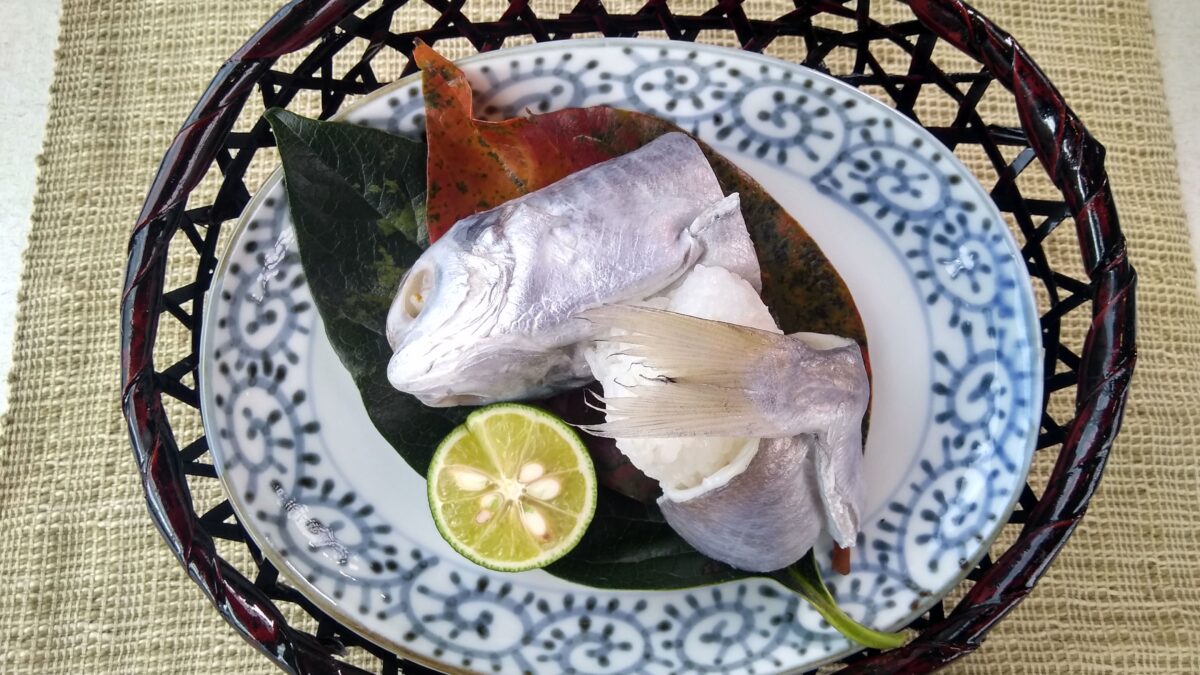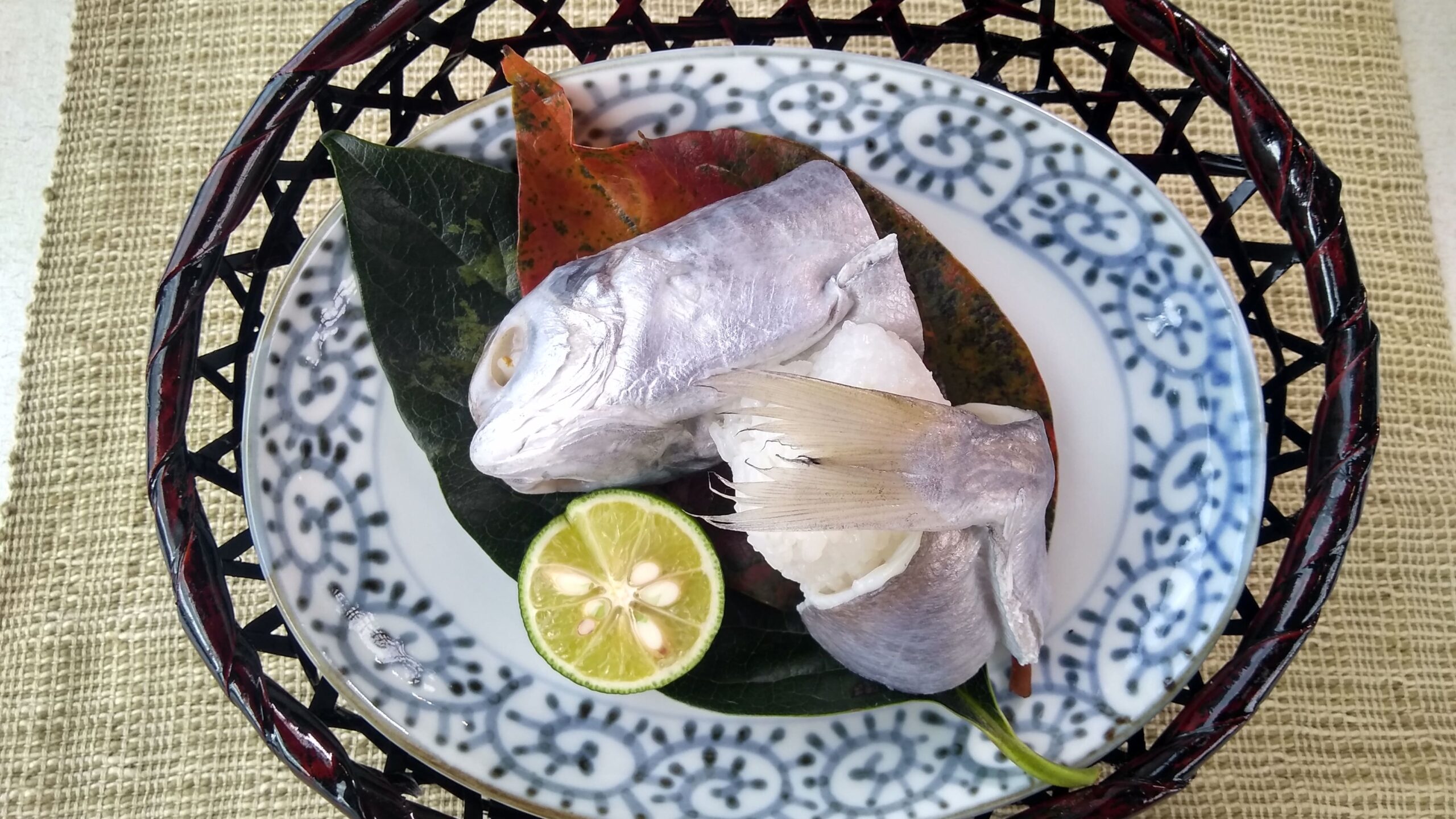
Alright, let’s head over to Tokushima Prefecture! Here, we’ll discover “Bouze no Sugata-zushi,” a type of sushi that’s as visually impressive as it is delicious. It’s all about showcasing the fish in its full glory, and it’s a real treat, especially during the fall festival season. Let’s get into the details of this vibrant dish!
Dish Name: Bouze no Sugata-zushi
- Region / Location: Southern Tokushima Prefecture, throughout the prefecture
- Primary Area of Tradition: Southern Tokushima, throughout Tokushima Prefecture
- Main Ingredients: Bouze (Ibodai/Pacific butterfish), sushi rice
How It’s Eaten / Served
Bouze no Sugata-zushi is made by butterflying a bouze, removing the bones, gills, eyes, and any bloodline, and then salting it. After about 30 minutes to an hour, the fish is marinated in vinegar for another hour. Sushi rice is shaped to match the size of the bouze and then wrapped with the fish to create a pressed sushi. Sometimes, fragrant ingredients like sudachi or yuzu are mixed into the sushi rice for an extra layer of flavor. For the best flavor melding, it’s recommended to press the sushi for a long time, even overnight.
Cultural Background and Preservation
During the autumn festival season, “Sugata-zushi,” where various fish are used whole to make sushi, is a common sight in Tokushima. This festive dish features sushi rice wrapped in butterflied fish. While fish likeaji (horse mackerel) and konoshiro (gizzard shad) are used, “bouze” was traditionally the star. “Bouze” is the local name in Tokushima for ibodai (Pacific butterfish), also known as ubose or shizu, a white-fleshed fish caught from summer to autumn. While bouze is enjoyed throughout Japan grilled, simmered, or dried, using it for Sugata-zushi is unique to Tokushima, where fresh bouze is readily available. The freshness of the fish makes it easier to prepare as Sugata-zushi because the flesh is firmer. However, the catch of bouze has been declining, so mackerel and Pacific saury are increasingly being used as substitutes.
During autumn festivals, Bouze no Sugata-zushi is served alongside sekihan (red bean rice), kakimaze-zushi (scattered sushi), clear soup, and amazake (sweet rice drink). Besides being served as the whole-form Sugata-zushi, the fish is also prepared as “Bouze no Nigiri,” where fillets are pickled in salt and vinegar and then used as a topping for hand-shaped sushi rice.
While some families still make it at home for festive occasions, Sugata-zushi is also readily available in supermarkets during the autumn festival season. The Tokushima Prefectural Government is also working to promote this dish. Their website features a recipe for “Bouze no Nigiri” in the “Fisherman’s Table Autumn/Winter” section, and “Tokushima’s Local Cuisine” website provides information on the history and recipe of Sugata-zushi.
Additional information:
- Bouze (ボウゼ): The local name in Tokushima for Ibodai or Pacific butterfish.
- Sugata-zushi (姿寿司): A type of sushi where the fish is used whole or in a large fillet to cover the sushi rice.
- Aji (鯵): Horse mackerel.
- Konoshiro (コノシロ): Gizzard shad.
- Sudachi (すだち): A small, round, green citrus fruit native to Japan.
- Yuzu (柚子): A Japanese citrus fruit with a fragrant aroma.
- Sekihan (赤飯): Rice cooked with red beans.
- Kakimaze-zushi (かきまぜ寿司): Scattered sushi.
- Amazake (甘酒): A sweet, non-alcoholic drink made from fermented rice.
The information about regional cuisine featured on this website (Piggy's Grandma of Japan) is summarized and adapted from the Ministry of Agriculture, Forestry and Fisheries of Japan (MAFF) website, "Our Regional Cuisines"Additional commentary is provided based on the unique experiences and perspectives of the site's editors.
The copyright for the original content regarding regional cuisine belongs to the Ministry of Agriculture, Forestry and Fisheries of Japan.
The summaries and adaptations published on this site are intended for informational purposes only. Piggy's Grandma of Japan does not guarantee the accuracy or completeness of this information. For the most accurate and complete details, please refer to the original pages on the MAFF website.



